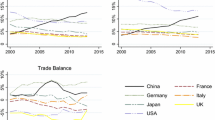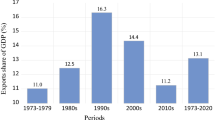Abstract
European Exports and Outward Foreign Direct Investment: A Dynamic Panel Data Approach. — This paper implements a panel data approach for studying the determinants of and relationships between bilateral economic activities in terms of both trade and foreign direct investment between the EU member states. The familiar equation for testing the determinants of bilateral exports is reformulated to reflect recent theoretical work. It is specified as a dynamic panel data model designed to answer questions about their relationship according to changes in different exogenous determinants. Exports and stocks of outward FDI are found to be substitutes with respect to changes in transport costs and complements with respect to most of the other determinants.
Similar content being viewed by others
References
Arellano, M., and S. Bond (1991). Some Tests of Specification for Panel Data: Monte Carlo Evidence and an Application to Employment Equations.Review of Economic Studies 58 (2): 277–297.
Baldwin, R. (1994).Towards an Integrated Europe. London: CEPR.
Baltagi, B. (1995).Econometric Analysis of Panel Data. Chichester: Wiley.
Bayoumi, T., and B. Eichengreen (1995). Is Regionalism Simply a Diversion? Evidence from the Evolution of the EC and EFTA. NBER Working Paper 5283. NBER, Cambridge, Mass.
Bellak, C. (1996). International Capital Mobility — A Note.Journal of International Money and Finance 15 (5): 825–828.
Bergstrand, J. H. (1985). The Gravity Equation in International Trade: Some Microeconomic Foundations and Empirical Evidence.Review of Economics and Statistics 67 (3): 474–481.
Bergstrand, J. H. (1989). The Generalized Gravity Equation, Monopolistic Competition, and Factor Proportions Theory in International Trade.Review of Economics and Statistics 71 (1): 143–153.
Bergstrand, J. H. (1990). The Heckscher-Ohlin-Samuelson Model, the Linder Hypothesis and the Determinants of Bilateral Intra-Industry Trade.Economic Journal 100 (403): 1216–1229.
Blomström, M., and A. Kokko (1994). Home Country Effects of Foreign Direct Investment: Evidence from Sweden. NBER Working Paper 4639. NBER, Cambridge, Mass.
Brainard, L. S. (1993). A Simple Theory of Multinational Corporations and Trade with a Trade-off between Proximity and Concentration. NBER Working Paper 4269. NBER, Cambridge, Mass.
Brainard, L. S. (1997). An Empirical Assessment of the Proximity-Concentration Tradeoff between Multinational Sales and Trade.American Economic Review 87 (4): 520–544.
Brenton P., F. DiMauro, and M. Lücke (1999). Economic Integration and FDI: An Empirical Analysis of Foreign Investment in the EU and in Central and Eastern Europe.Empirica 26 (2): 95–121.
Carr, D. L., J. R. Markusen, and K. E. Maskus (1998). Estimating the Knowledge-Capital Model of the Multinational Enterprise. NBER Working Paper 6773. NBER, Cambridge, Mass.
Caves, R. E. (1996).Multinational Enterprise and Economic Analysis. Cambridge: Cambridge University Press.
Cushman, D. O. (1988). Exchange Rate Uncertainty and Foreign Direct Investment in the United States.Weltwirtschaftliches Archiv 124 (2): 322–336.
Dixit, A. K., and J. E. Stiglitz (1977). Monopolistic Competition and Optimum Product Diversity.American Economic Review 67 (3): 297–308.
Dunning, J. H. (1981).International Production and the Multinational Enterprise. London: Allen & Unwin.
Egger, P., and M. Pfaffermayr (2000). Trade, Multinational Sales, and FDI in a Three-Factors Model. University of Linz Working Paper 0013. University of Linz.
Frank, R. H., and R. T. Freeman (1978).Distributional Consequences of Direct Foreign Investment. New York: Academic Press.
Geraci, V. J., and W. Prewo (1976). Bilateral Trade Flows and Transport Costs.Review of Economics and Statistics 59 (1): 67–74.
Grossman, G. M., and E. Helpman (1991).Innovation and Growth in the Global Economy. Cambridge, Mass.: MIT Press.
Hansen, L. P. (1982). Large Sample Properties of Generalized Methods of Moments Estimators.Econometrica 50 (4): 1029–1054.
Helpman, E. (1984). A Simple Theory of International Trade with Multinational Corporations.Journal of Political Economy 92 (3): 451–471.
Helpman, E. (1987). Imperfect Competition and International Trade: Evidence from Fourteen Industrial Countries.Journal of the Japanese and International Economies 1 (1): 62–81.
Helpman, E., and P. R. Krugman (1985).Market Structure and Foreign Trade. Cambridge, Mass.: MIT Press.
Hummels, D., and J. Levinsohn (1995). Monopolistic Competition and International Trade: Reconsidering the Evidence.Quarterly Journal of Economics 110 (3): 799–836.
Koizumi, T., and K. J. Kopecky (1980). Foreign Direct Investment, Technology Transfer and Domestic Employment Effects.Journal of International Economics 10 (1): 1–20.
Linnemann, H. (1966).An Econometric Study of International Trade Flows. Amsterdam: North-Holland.
Lipsey, R. E., and M. Y. Weiss (1981). Foreign Production and Exports in Manufacturing Industries.Review of Economics and Statistics 63 (4): 488–494.
Lipsey, R. E., and M. Y. Weiss (1984). Foreign Production and Exports of Individual Firms.Review of Economics and Statistics 66 (2): 304–308.
Lucas, R. E. (1967). Optimal Investment Policy and the Flexible Accelerator.International Economic Review 8 (1): 78–85.
Lütkepohl, H. (1993).Introduction to Multiple Time Series Analysis. Berlin: Springer.
Markusen J. R., and K. E. Maskus (1999a). Multinational Firms: Reconciling Theory and Evidence. NBER Working Paper 7163. NBER, Cambridge, Mass.
Markusen J. R., and K. E. Maskus (1999b). Discriminating among Alternative Theories of the Multinational Enterprise. NBER Working Paper 7164. NBER, Cambridge, Mass.
Markusen, J. R., and A. Venables (1998). Multinational Firms and the New Trade Theory.Journal of International Economics 46 (2): 183–203.
Markusen, J. R., and A. Venables (2000). The Theory of Endowment, Intra-Industry, and Multinational Trade.Journal of International Economics 52 (2): 209–234.
Martín, C., and F. Velàzquez (1997). The Determining Factors of Foreign Direct Investment in Spain and the Rest of the OECD: Lessons for the CEECs. CEPR Discussion Paper 1637. CEPR, London.
Mathieu, C. (1995). Panel Data, Multinational Enterprises and Direct Investment. In L. Mátyás and P. Sevestre (ed.),The Econometrics of Panel Data. A Handbook of the Theory with Applications. Dordrecht: Kluwer Academic Publishers.
Mátyás, L. (1997). Proper Econometric Specification of the Gravity Model.World Economy 20 (3): 363–368.
Mennel, A., and J. Foerster (1997).Steuern in Europa, Amerika und Asien. Berlin: Verlag Neue Wirtschafts-Briefe.
OECD (1999).Measuring Globalization: The Role of Multinationals in OECD Economies. Paris: OECD.
Oguledo, V. I., and C. R. MacPhee (1994). Gravity Models: A Reformulation and an Application to Discriminatory Trade Arrangements.Applied Economics 26 (2): 107–120.
Pfaffermayr, M. (1996). Foreign Outward Direct Investment and Exports in Austrian Manufacturing: Substitutes or Complements?Weltwirtschaftliches Archiv 132 (3): 501–521.
Pöyhönen, P. (1963). A Tentative Model for the Volume of Trade between Countries.Weltwirtschaftliches Archiv 90 (1): 93–99.
Sargan, J. D. (1958). The Estimation of Economic Relationships Using Instrumental Variables.Econometrica 26 (2): 393–415.
Sevestre, P., and A. Trognon (1995). Dynamic Linear Models. In L. Mátyás and P. Sevestre (ed.),The Econometrics of Panel Data. A Handbook of the Theory with Applications. Dordrecht: Kluwer Academic Publishers.
Svensson, R. (1996). Effects of Overseas Production on Home Country Exports: Evidence Based on Swedish Multinationals.Weltwirtschaftliches Archiv 132 (2): 304–329.
Swedenborg, B. (1979).The Multinational Operations of Swedish Firms. An Analysis of Determinants and Effects. Stockholm: The Industrial Institute for Economic and Social Research.
Tinbergen, J. (1962).Shaping the World Economy. Suggestions for an International Economic Policy. New York: The Twentieth Century Fund.




